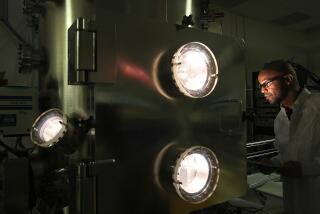Allen E. Puckett dies at 94; top defense executive and engineer
Allen E. Puckett, one of the engineers who after World War II built Los Angeles-based Hughes Aircraft Co. into the nation’s leading defense electronics firm — dominant in the markets for air defense, radar systems, tactical missiles and satellites — has died. He was 94.
One of the nation’s top technologists and defense executives during the Cold War, Puckett died March 31 at his home in Pacific Palisades after suffering a stroke. His wife, Marilyn, confirmed his death.
“Allen Puckett was one of the guiding spirits of Hughes Aircraft,” said Malcolm Currie, a former deputy defense secretary who later followed in Puckett’s footsteps as another president of the company. “He was brilliant. He was the father of our nation’s guided missiles.”
Although he never gave up his technical role, Puckett took over as chief executive of the firm in 1978 and navigated the enterprise through its sale to General Motors in June 1985. His management style encouraged technical excellence, according to former Hughes scientists.
“Puckett allowed things to exist by not squelching creativity,” recalled Howard Laitin, a chief scientist at the company. “He understood that you couldn’t suppress people who were motivated and he created a bottoms-up organization. Everybody had a title and nobody admitted to working for anybody.”
Puckett’s ascendancy in the company came early in his career, when he played a key role in developing the founding technology that gave Hughes Aircraft a big chunk of its business. By the early 1950s, the U.S. was growing increasingly concerned about the ability of Soviet Union bombers to penetrate U.S. airspace.
The U.S. needed a better air defense system and turned to Hughes, which was establishing an expertise in the still-new field of radar. Hughes came up with a long range radar-guided missile, the Falcon, putting Soviet bombers at risk before they could approach their U.S. targets.
Puckett, who studied aerospace engineering at Harvard University and then earned a doctorate at Caltech, pioneered an aerodynamic control system that relied on rear fins, according to Kenneth Richardson, a former Hughes president who also followed in Puckett’s footsteps.
“Allen created the wing form and the rear control system,” Richardson said. “It had low aerodynamic drag and it was highly maneuverable.”
Under Puckett’s stewardship, Hughes later captured the lion’s share of the military’s ground and air radar businesses, supplying the airborne radars used in the F-14, F-15, F-18 and B-2 aircraft and selling air defense systems around the world.
By the time of the first Gulf War, the Defense Department deployed 88 different weapons systems built by Hughes. At its peak, Hughes was the largest industrial employer in California with a workforce of 85,000, including 4,000 people with doctorates on its technical staff.
Puckett won a long list of awards, including the French Legion of Honor and the National Technology Medal. He also was a member of the National Academy of Engineering. He was born in Springfield, Ohio, on July 25, 1919, and he completed his undergraduate studies in 1939. His doctoral thesis laid down the design principles for swept-wing supersonic jets.
The late Albert Wheelon, a former deputy director of the Central Intelligence Agency, once said he joined Hughes largely because of Puckett.
“I was a great admirer of Allen,” said Wheelon, who helped build Hughes into the world’s dominant communications satellite manufacturer. It was Puckett, Wheelon said, who held the company together in the early 1950s during the exodus of some of its top talent, including Simon Ramo, Dean Wooldridge, Roy Ash and Charles B. “Tex” Thornton. They later formed major competitors to Hughes.
Laitin recalled Puckett as a jovial executive, though to outsiders he seemed cautious and reserved. Puckett focused on technology, leaving marketing and management of the secretive company to other senior executives. Until the early 1980s, Hughes operated in such a vacuum that its corporate spokesman Lee Pitt once boasted, “We don’t give anybody the time of day.”
As the end of Puckett’s career approached in the mid-1980s, the defense industry shifted and the era when technological supremacy mattered above all else was ending. The company ran into a series of problems with quality control and cost overruns, much like other defense contractors.
And the company’s unusual legal structure was about to crumble and Puckett could do little to stop it. Eccentric billionaire Howard Hughes had originally owned the company and then put it into a nonprofit medical institute controlled by his cronies.
A series of court and tax rulings, however, forced the Howard Hughes Medical Institute to sell the company after Howard Hughes died and GM won the auction. Puckett retired from Hughes in 1987, as the automaker was learning about some of the problems embedded in its new defense subsidiary and was demanding a partial refund on its $5.2-billion acquisition.
GM ultimately sold off Hughes piecemeal for big profits, dissolving one of the nation’s leading technological firms.
“They dismembered the company,” said Richardson, who has written a history of Hughes Aircraft.
Puckett funded a research chair in engineering at Harvard University and a laboratory at Caltech and served on the board of trustees at USC. And in his retirement, he engaged his passion for sailing. He kept a yacht in Marina del Rey and entered races along the Pacific coast.
Besides his wife of 50 years, Puckett is survived by five children, Allen W. Puckett, Nancy Grant, Susan Prislin, Margaret Harris and James R. Puckett; six grandchildren and 14 great-grandchildren.
More to Read
Start your day right
Sign up for Essential California for the L.A. Times biggest news, features and recommendations in your inbox six days a week.
You may occasionally receive promotional content from the Los Angeles Times.







